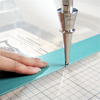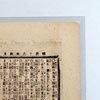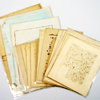

 |
 |

Materials that are still too fragile to handle after conservation
treatment can be sealed inside inert transparent polyester film
sheets. This method chemically delays deterioration by protecting deacidified
materials from oxygen. Additionally, it is also
thought to be effective in protecting materials prone to reaction with alkali. Because the encapsulating envelope is transparent, the material
can be viewed, exhibited and reproduced. Since the envelope is ultrasonically sealed
along the edges only, the materials can be easily removed from the
envelope if required.
The critical factor with encapsulation is the deacidification of
acid paper. If this is not performed, acidic substances may continue
to degrade the paper inside the film envelope causing more damage
than if the materials had not been encapsulated. Documents that are weak against alkali and cannot be deacidified, such as cyanotype (blueprints), etc.,
are encapsulated along with nonbuffer paper, VOC (volatile organic
compound)-absorption paper, or alkaline buffer paper, etc. These buffer papers are
required to absorb the acidic substances that may be generated by
the materials.
In addition, encapsulation is not recommended for the following materials:
documents written in pastel or other powder-based materials; papers
with fragile surfaces; materials, such as Ukiyoe woodblock prints,
which have slightly embossed or raised areas. |
 |
 |
 |

 |
 |
 |
 |
 |
 |
 |
 |
 |
|
| Ultrasonic sealing of the film envelope |
|
|
|
|
|
|
| Treatment of diazotype, cyanotype, etc. |
|
|
|
 |
 |
•Polyester film
Inert, deterioration-resistant polyester made into a transparent
film. |
•Acid paper
Slightly acidic paper, sized or fixed with aluminum sulfate, rosin,
etc., that causes deterioration. |
•Nonbuffer paper
Paper without acidity or alkalinity. |
•Alkaline buffer paper
Paper treated with an alkaline buffer. |
|
|
|
 |